Hypoendocrine states - Study guides, Class notes & Summaries
Looking for the best study guides, study notes and summaries about Hypoendocrine states? On this page you'll find 41 study documents about Hypoendocrine states.
Page 3 out of 41 results
Sort by
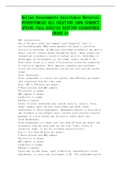
-
Relias Assessments Assistance Material DYSRHYTHMIAS ALL SOLUTION 100% CORRECT SPRING FALL-2023/24 EDITION GUARANTEED GRADE A+
- Other • 6 pages • 2023
-
- $10.39
- + learn more
EKG interpretation One of the most useful and commonly used diagnostic tools is electrocardiography (EKG) which measures the heart's electrical activity as waveforms. An EKG uses electrodes attached to the skin to detect electric current moving through the heart. These signals are transmitted to produce a record of cardiac activity. Arrhythmia or dysrhythmia are disturbances in the normal cardiac rhythm of the heart which occurs as a result of alterations within the conduction of electrical im...
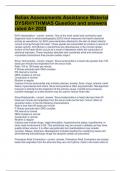
-
Relias Assessments Assistance Material DYSRHYTHMIAS Question and answers rated A+ 2023
- Exam (elaborations) • 5 pages • 2023
-
Available in package deal
-
- $13.49
- + learn more
Relias Assessments Assistance Material DYSRHYTHMIAS Question and answers rated A+ 2023EKG interpretation One of the most useful and commonly used diagnostic tools is electrocardiography (EKG) which measures the heart's electrical activity as waveforms. An EKG uses electrodes attached to the skin to detect electric current moving through the heart. These signals are transmitted to produce a record of cardiac activity. Arrhythmia or dysrhythmia are disturbances in the normal cardiac rhythm of th...

-
Relias Assessments Assistance Material DYSRHYTHMIAS
- Other • 4 pages • 2023
-
- $10.49
- + learn more
EKG interpretation - Answer- One of the most useful and commonly used diagnostic tools is electrocardiography (EKG) which measures the heart's electrical activity as waveforms. An EKG uses electrodes attached to the skin to detect electric current moving through the heart. These signals are transmitted to produce a record of cardiac activity. Arrhythmia or dysrhythmia are disturbances in the normal cardiac rhythm of the heart which occurs as a result of alterations within the conduction of elec...
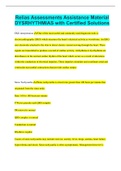
-
Relias Assessments Assistance Material DYSRHYTHMIAS with Certified Solutions
- Exam (elaborations) • 10 pages • 2023
-
Available in package deal
-
- $9.99
- + learn more
Relias Assessments Assistance Material DYSRHYTHMIAS with Certified Solutions EKG interpretation One of the most useful and commonly used diagnostic tools is electrocardiography (EKG) which measures the heart's electrical activity as waveforms. An EKG uses electrodes attached to the skin to detect electric current moving through the heart. These signals are transmitted to produce a record of cardiac activity. Arrhythmia or dysrhythmia are disturbances in the normal cardiac rhythm of the heart wh...
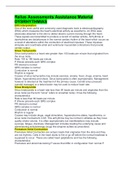
-
Relias Assessments Assistance Material DYSRHYTHMIAS, Complete Solution
- Exam (elaborations) • 5 pages • 2022
-
Available in package deal
-
- $9.49
- + learn more
Relias Assessments Assistance Material DYSRHYTHMIAS EKG interpretation One of the most useful and commonly used diagnostic tools is electrocardiography (EKG) which measures the heart's electrical activity as waveforms. An EKG uses electrodes attached to the skin to detect electric current moving through the heart. These signals are transmitted to produce a record of cardiac activity. Arrhythmia or dysrhythmia are disturbances in the normal cardiac rhythm of the heart which occurs as a result ...
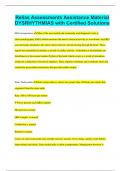
-
elias Assessments Assistance Material DYSRHYTHMIAS with Certified Solutions
- Exam (elaborations) • 10 pages • 2023
-
- $10.49
- + learn more
EKG interpretation One of the most useful and commonly used diagnostic tools is electrocardiography (EKG) which measures the heart's electrical activity as waveforms. An EKG uses electrodes attached to the skin to detect electric current moving through the heart. These signals are transmitted to produce a record of cardiac activity. Arrhythmia or dysrhythmia are disturbances in the normal cardiac rhythm of the heart which occurs as a result of alterations within the conduction of electrical...
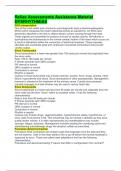
-
Relias Assessments Assistance Material DYSRHYTHMIAS
- Exam (elaborations) • 5 pages • 2024
-
- $10.99
- + learn more
Relias Assessments Assistance Material DYSRHYTHMIAS EKG interpretation One of the most useful and commonly used diagnostic tools is electrocardiography (EKG) which measures the heart's electrical activity as waveforms. An EKG uses electrodes attached to the skin to detect electric current moving through the heart. These signals are transmitted to produce a record of cardiac activity. Arrhythmia or dysrhythmia are disturbances in the normal cardiac rhythm of the heart which occurs as a result ...
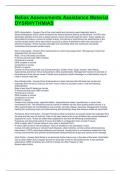
-
Relias Assessments Assistance Material DYSRHYTHMIAS
- Exam (elaborations) • 4 pages • 2024
-
- $7.69
- + learn more
Relias Assessments Assistance Material DYSRHYTHMIAS EKG interpretation - Answer-One of the most useful and commonly used diagnostic tools is electrocardiography (EKG) which measures the heart's electrical activity as waveforms. An EKG uses electrodes attached to the skin to detect electric current moving through the heart. These signals are transmitted to produce a record of cardiac activity. Arrhythmia or dysrhythmia are disturbances in the normal cardiac rhythm of the heart which occurs as...
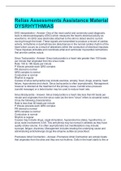
-
Relias Assessments Assistance Material DYSRHYTHMIAS
- Exam (elaborations) • 5 pages • 2023
-
- $9.29
- + learn more
EKG interpretation - Answer- One of the most useful and commonly used diagnostic tools is electrocardiography (EKG) which measures the heart's electrical activity as waveforms. An EKG uses electrodes attached to the skin to detect electric current moving through the heart. These signals are transmitted to produce a record of cardiac activity. Arrhythmia or dysrhythmia are disturbances in the normal cardiac rhythm of the heart which occurs as a result of alterations within the conduction of elec...
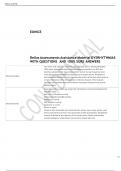
-
EUNICE Relias Dysrhythmia WITH QUESTIONS AND 100% SURE ANSWERS
- Exam (elaborations) • 5 pages • 2024
- Available in package deal
-
- $9.99
- + learn more
EUNICE Relias Assessments Assistance Material DYSRHYTHMIAS WITH QUESTIONS AND 100% SURE ANSWERS EKG interpretation One of the most useful and commonly used diagnostic tools is electrocardiography (EKG) which measures the heart's electrical activity as waveforms. An EKG uses electrodes attached to the skin to detect electric current moving through the heart. These signals are transmitted to produce a record of cardiac activity. Arrhythmia or dysrhythmia are disturbances i...

Study stress? For sellers on Stuvia, these are actually golden times. KA-CHING! Earn from your study resources too and start uploading now. Discover all about earning on Stuvia


